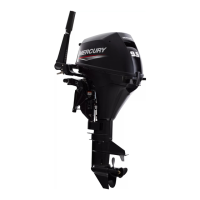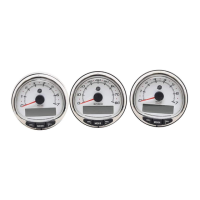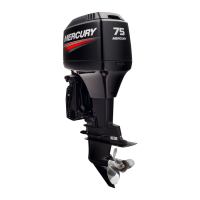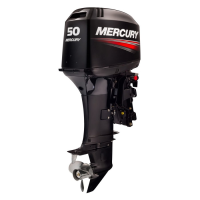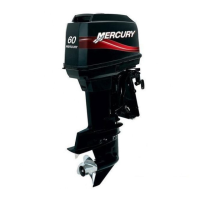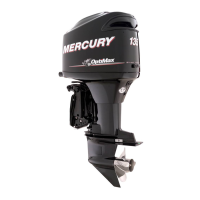90-830234R3 DECEMBER 1997 ELECTRICAL - 2B-5
9 Ampere (Manual Start) BLACK
Stator Output Test
The 9 ampere stator that comes with manual start
models is NOT designed to produced its rated am-
perage at low engine speeds (to charge batteries) but
rather as a power source for running lights. However,
if a rectifier kit is installed on the engine to enable the
stator to charge a battery, the following approximate
output can be checked at the listed RPM with an in–
series ammeter:
RPM AMPERES
Idle 0.0
1000 0.0
BLACK Stator
2000 6.0
3000 9.0
4000 10.0
5000 10.0
BLACK Stator Ohms Test
(Alternator Coils Only)
NOTE: Stator can be tested without removing from
engine.
1. Disconnect both YELLOW (stator leads) from ter-
minals on rectifier (or terminal block).
2. Use an ohmmeter and perform the following test.
IMPORTANT: If stator is mounted on engine,
black stator lead (if provided) must be grounded
to powerhead when testing.
3. Replace stator if readings are outside ranges
shown.
BLACK STATOR
Test Leads
Resistance
(Ohms)
Scale Reading
(x
)
9/14/16 AMPERE STATORS
Between YELLOW
stator leads
.1 – .5
.1 – .5
(R x 1)
Between either
YELLOW stator lead
and engine ground**
No
Continuity
No
Continuity
(R x 1000)
* DC resistance of these windings generally is less than
1.5 ohms. If a reading (resembling a short) is obtained,
this would be acceptable.
** If stator is removed from engine, connect test lead to
black stator lead, if provided.
4. If meter readings are other than specified, re-
place stator.
BLACK Stator 14 and 16 Ampere
Alternator System Test
1. Check battery voltage at battery with engine run-
ning.
2. If battery voltage is above 14.5 volts, replace volt-
age regulator/rectifier. Check condition of battery
as overcharging may damage battery.
3. If battery voltage is below 14.5 volts, charge bat-
tery; refer to “Charging a Discharged Battery”,
preceding. If battery can NOT be satisfactorily
charged, replace battery.
4. If battery accepts a satisfactory charge, check
battery voltage while cranking engine; refer to
“Charging a Discharged Battery”, preceding. If
cranking voltage is not acceptable, replace battery.
5. If cranking voltage is acceptable, disconnect
larger diameter RED wire from STARTER SOLE-
NOID terminal.
6. Remove smaller diameter RED wire (SENSE
LEAD) from STARTER SOLENOID terminal and
connect to the POSITIVE (+) terminal of a 9 VOLT
transistor battery. Ground the NEGATIVE (–) ter-
minal of the 9 VOLT battery to the engine.
7. Connect RED (+) ammeter lead to larger diame-
ter RED wire, and BLACK (–) ammeter lead to
POSITIVE terminal on STARTER SOLENOID.
8. Secure wires away from flywheel.
9. With engine running at the indicated RPM’s, the
ammeter should indicate the following approxi-
mate amperes:
RPM AMPERES
Idle 4.0
1000 8.0
14 Ampere Stator
2000 11.0
3000 13.0
4000 14.0
5000 14.0
RPM AMPERES
Idle 5.0
1000 10.0
16 Ampere Stator
2000 16.0
3000 17.0
4000 18.0
5000 18.0

